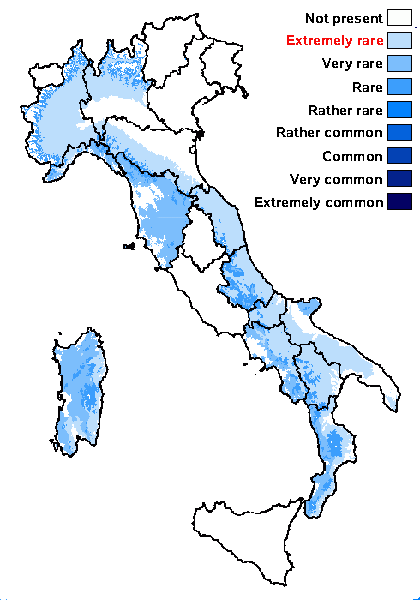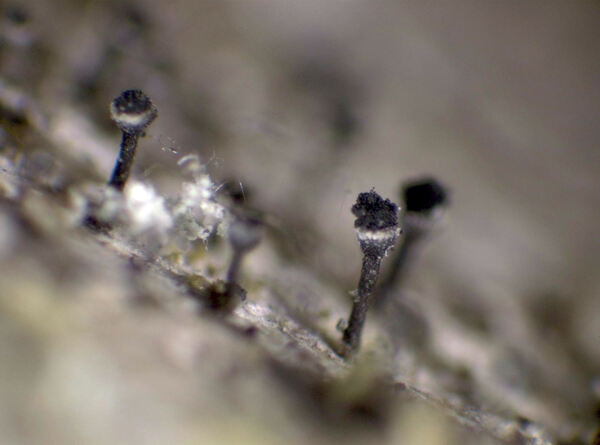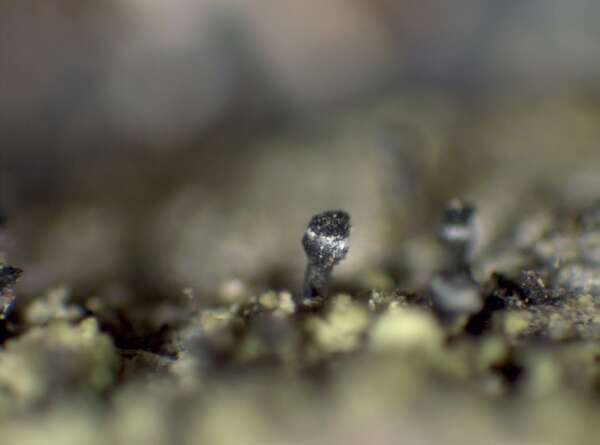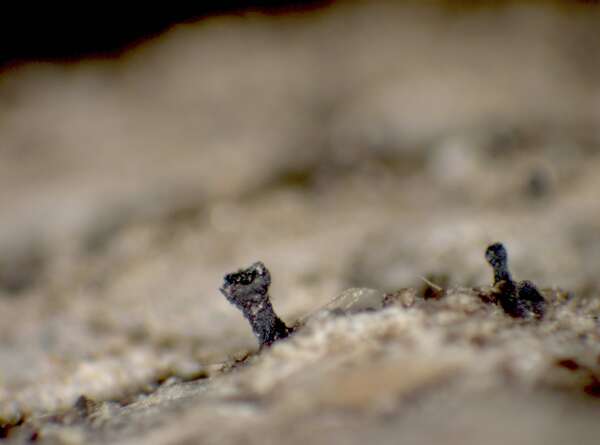Calicium quercinum Pers.
Tent. Disp. Meth. Fung., Suppl.: 59, 1797.
Synonyms: Calicium curtiusculum Nyl.; Calicium decipiens A. Massal.; Calicium lenticulare var. bacillare Ach.
Distribution: N - Lomb (Puntillo & Puntillo 2009), Piem (Isocrono & al. 2004, Puntillo & Puntillo 2009), Emil (Tretiach & al. 2008, Fariselli & al. 2020), Lig (Jatta 1909-1911). C - Tosc (Tretiach & Nimis 1994, Puntillo & Puntillo 2009, Benesperi 2011), Marc (Puntillo & Puntillo 2009), Umbr (Ravera & al. 2021b), Abr (Nimis & Tretiach 1999, Puntillo & Puntillo 2009), Mol (Nimis & Tretiach 1999, Caporale & al. 2008), Sar (Zedda 2002, 2002b, Puntillo & Puntillo 2009). S - Camp (Garofalo & al. 1999, Aprile & al. 2003b), Pugl (Thüs & Licht 2006), Bas (Nimis & Tretiach 1999, Puntillo & Puntillo 2009), Cal (Puntillo 1994, 1996, Puntillo & Puntillo 2009).
Description: Thallus crustose, episubstratic, rather thick, minutely granular, grey-green. Apothecia long-stalked, pin-like, black, but white-pruinose on the edges and lower side of capitulum. Stalk black, matt, medium brown in section, (0.5-)0.8-1.3 mm high, 0.08-0.24 mm thick, of 2-3 µm thick, sclerotized, densely and irregularly interwoven hyphae. Capitulum lenticular, (0.2-)0.4-0.6 mm across, with a black mazaedium. Exciple well-developed, cup-shaped, 30-50 µm wide laterally, of spherical to slightly elongated and anticlinally arranged cells; hypothecium medium brown, with a slightly convex upper surface, of interwoven, sclerotized hyphae. Asci cylindrical, formed singly, dissolving early, with uniseriately to rarely biseriately arranged ascospores. Ascospores 1-septate, dark brown, ellipsoid, 9-13 x 4-6 µm, thick-walled, with spirally arranged ridges and irregular cracks. Photobiont chlorococcoid. Spot tests: thallus K+ yellow turning red, C-, KC-, P+ yellow; ascomata I- in all parts. Chemistry: thallus with norstictic acid.Note: a temperate to boreal-montane, holarctic species found on lignum and on acid bark, especially on decorticated stumps of conifers, but also on broad-leaved trees, e.g. on Castanea, widespread throughout Italy, but not common.
Growth form: Crustose
Substrata: bark and lignum
Photobiont: green algae other than Trentepohlia
Reproductive strategy: mainly sexual
In underhangs rarely wetted by rain
Commonnes-rarity: (info)
Alpine belt: absent
Subalpine belt: absent
Oromediterranean belt: absent
Montane belt: rare
Submediterranean belt: extremely rare
Padanian area: absent
Humid submediterranean belt: very rare
Humid mediterranean belt: absent
Dry mediterranean belt: absent

Predictive model
Herbarium samples
Growth form: Crustose
Substrata: bark and lignum
Photobiont: green algae other than Trentepohlia
Reproductive strategy: mainly sexual
In underhangs rarely wetted by rain
Commonnes-rarity: (info)
Alpine belt: absent
Subalpine belt: absent
Oromediterranean belt: absent
Montane belt: rare
Submediterranean belt: extremely rare
Padanian area: absent
Humid submediterranean belt: very rare
Humid mediterranean belt: absent
Dry mediterranean belt: absent

Predictive model
| Herbarium samples |
 Index Fungorum
Index Fungorum
 GBIF
GBIF





